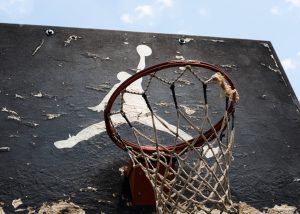Nike Prevails In Copyright Case As SCOTUS Rejects Review Of 'Jumpman' Logo
With the high court’s denial of the cert petition, Nike has emerged victorious.

(Image via Getty)
Earlier this week, the Supreme Court rejected review a case involving whether the famous Nike “Jumpman” logo infringed an earlier photograph of Michael Jordan. The Ninth Circuit previously granted summary judgment for Nike, finding that the company’s image and logo did not infringe upon an earlier image. With the high court’s denial of the cert petition, Nike has emerged victorious.
The facts: Jacobus Rentmeester, then a college student, photographed Michael Jordan for Life magazine. Rentmeester’s photograph was considered highly original, at least in part because of the pose he had Jordan assume. Rentmeester asserts that the pose was unusual for a basketball player, inspired by a leap in ballet, with one hand holding a basketball as if Jordan was getting ready to dunk the ball. Rentmeester also noted he made specific choices about camera angle, background, shutter speed, composition, and lighting. Time Magazine named Rentmeester’s photograph one of the 100 most influential photographs of all time. Subsequently, Nike produced a similar photograph with the same type of leap, but included a few changes: Jordan is wearing his Chicago Bulls uniform, the Chicago skyline is in the background, and there were also small changes to where Jordan appears in the photograph, the position of the basketball hoop, and the angles of Jordan’s right hand and foot as he jumps. The silhouette from Nike’s photograph was used to create the “Jumpman” logo and is probably Nike’s second most recognizable trademark after the “swoosh” logo. Rentmeester waited until 2015 to sue, after he retired from his professional photography career.

Is The Future Of Law Distributed? Lessons From The Tech Adoption Curve
Photographs are, of course, copyrightable. SCOTUS confirmed in 1884 that photographs fall under the scope of copyrightability (they were not included in the list of copyrightable subject matter in the 1802 Copyright Act, likely owing to the fact that photographs didn’t exist at that time) in Burrow-Giles Lithographic v. Sarony. There, the Court noted that the photograph at issue was not a “mere mechanical reproduction,” but involved the photographer’s choice of composition, pose, costume, accessories, lighting, shading, arrangement, and other elements.
While the exact photograph itself is copyrightable, it’s important to keep in mind that ideas are not protectable, only the original expression. This idea/expression dichotomy is critical in ensuring that monopoly protection does not unnecessarily lock up knowledge and prevent others from enjoying the “progress of science and useful arts.” Rentmeester sued Nike, arguing that the photograph and Jumpman logo was “substantially similar” to the 1984 photo he took. @KyleJahner has a great side by side of the two images which, on first glance are no question similar, but whether they are “substantially similar” for copyright purposes was in dispute. No doubt, the concept in Nike’s photograph was based on Rentmeester’s image, but that fact is not determinative of whether copyright infringement occurred.
Take the classic example of a bear catching salmon. This concept is certainly in the public domain and not protectable by copyright. While it may make for an excellent photograph and the particular choices made in each photograph — angle, lighting, composition, shutter speed, aperture, etc. — can result in original expression worthy of copyright protection, the idea itself is free for anyone to use. Just image search “bear catching salmon” and hundreds of similar versions will appear, though they invoke different timing, different angles, and (arguably) different emotions. Instead, a photographer must establish substantial similarity for a valid copyright infringement case.
Here, the Ninth Circuit lays out the relevant analysis: an extrinsic test (assessing objective similarities between the works, based only on the protectable elements; stock features or material in the public domain are “filtered out”) and intrinsic test (whether the two works are subjectively and substantially similar in total concept and feel). A plaintiff must prevail on both to demonstrate copyright infringement.
Sponsored

Navigating Financial Success by Avoiding Common Pitfalls and Maximizing Firm Performance

Early Adopters Of Legal AI Gaining Competitive Edge In Marketplace

The Business Case For AI At Your Law Firm


Navigating Financial Success by Avoiding Common Pitfalls and Maximizing Firm Performance
The Ninth Circuit notes in its 2018 opinion that Rentmeester’s photograph is “entitled to broad rather than thin protection” given its distinctiveness in the pose and creative choice of background. However, the Ninth Circuit points out that despite similarities in the subject matter, Rentmeester’s photograph was not unlawfully appropriated: “Nike’s photpgrapher did not copy the details of the pose as expressed in Rentmeester’s photo; he borrowed only the general idea or concept embodied in the photo.” The court notes that the angles of the limbs were different, with the Rentmeester photo suggesting horizontal/forward movement, while Nike’s version was intended to invoke vertical movement and thus the expression is different. The court notes other distinguishing features that are “stark differences” from the position of the hoop to the fact that there is no foreground in the Nike photograph. Ultimately, the court finds, the similarities involve only non-copyrightable ideas and concepts. As a result, Nike’s photograph does not infringe Rentmeester’s photo and the resulting Jumpman logo is “even less similar . . . than the Nike photo itself.”
Krista L. Cox is a policy attorney who has spent her career working for non-profit organizations and associations. She has expertise in copyright, patent, and intellectual property enforcement law, as well as international trade. She currently works for a non-profit member association advocating for balanced copyright. You can reach her at kristay@gmail.com.
Sponsored

Is The Future Of Law Distributed? Lessons From The Tech Adoption Curve








